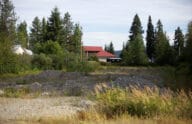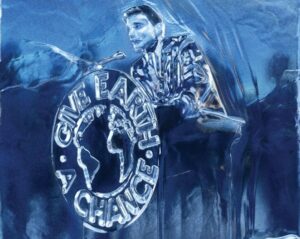Apocalyptic environmentalists want fewer humans on earth

Last July, two climate change activists, glued their hands to the 540-year-old Botticelli painting Primavera at the Uffizi Gallery in Florence, Italy. The painting, which depicts mythical figures in a green garden, is one of the most studied and praised in Western Civilization. It is thought to be an allegory about the abundance of nature.
A third activist then unrolled a banner that said, “Ultima Generazione No Gas No Carbone” (Last Generation No Gas No Coal). The activists call themselves Ultima Generazione. They believe that, without drastic government action, the world will soon be destroyed by climate change.
In the U.S. and Great Britain, the activist group Extinction Rebellion (or XR) uses similar tactics for the same reason. Front and center on its website is this dire text: “Life on Earth is in crisis. Our climate is changing faster than scientists predicted […] Social and ecological collapse. Mass extinction. We are running out of time, and our governments have failed to act.”
Extinction Rebellion frequently makes headlines for its “nonviolent” demonstrations, which mostly involve blocking traffic and public transport. Lest you assume this is strictly a college student movement, an 83-year-old XR activist glued his hand to the side of a subway car at one protest, saying he was doing it for his grandchildren, and that it upset him “to see God’s creation being wrecked across the world […] I’m longing for the government to take some actions…”
In another demonstration last year, climate activists blocked traffic to bring attention to their pet issue. A tearful woman begged them to move, as she was on her way to visit her sick mother at the hospital. After the incident, XR’s co-founder Roger Hallam was asked in an interview how he would’ve responded to the woman: “I’d have stayed there.” The interviewer then asked, “If it were an ambulance and there was someone in there that could potentially die, would you stay there?”
“Yep.”
Apocalyptic environmentalism
Environmental groups like XR and Ultima Generazione share two qualities: First, a panicked certainty that climate change is going to end life on earth very soon, or at least make it much worse for most of us, and second, that only governmental restrictions on liberty and property can prevent it.
Granted, these activists are on the radical end of the spectrum among environmentalists. But over the past 50 years, there has been a shift of the entire spectrum toward what author and longtime environmentalist Michael Shellenberger calls “apocalyptic environmentalism.” While most people who describe themselves as environmentalists don’t consciously identify with apocalyptic environmentalism, key policies they support have their intellectual origins in this fringe.
Environmentalism didn’t always have this apocalyptic tone. In fact, the early American conservation movement’s purpose was to protect and use natural resources for human benefit and enjoyment. Our relationship to the environment was one of mutual benefit.
Apocalyptic environmentalism, on the other hand, sees humanity and the environment as fundamentally at odds. Adherents are never far from advocating population reduction alongside demands for more government action.
By the late 2010s, distaste for humanity was so trendy in environmentalist circles that many began arguing it was unethical to bring more human beings into the world. The Cato Institute’s Chelsea Follett collected a sample of telling headlines:
Recent examples of writings that are warming to the idea of human extinction include The New Yorker’s ‘The Case for Not Being Born,’ NBC News’ ‘Science proves kids are bad for Earth. Morality suggests we stop having them,’ and The New York Times’ ‘Would Human Extinction Be a Tragedy?’ which muses that, ‘It may well be, then, that the extinction of humanity would make the world better off.’ Last month, the progressive magazine Fast Company released a disturbing video entitled, ‘Why Having Kids Is the Worst Thing You Can Do for the Planet.’
Follett also notes that apocalyptic environmentalism unsurprisingly celebrated what most people regarded as an awful and socially shattering pandemic in 2020: “The New York Times has noted that an upside of social-distancing efforts is that they may help fight climate change, and CNN ran the headline ‘There’s an unlikely beneficiary of coronavirus: The planet.’ The BBC’s environmental correspondent gleefully reported that air pollution and CO2 emissions fell rapidly as the virus spread.”
This attitude has become so deeply rooted within our own government that popular New York Congresswoman Alexandria Ocasio-Cortez once mused, “It is basically a scientific consensus that the lives of our children are going to be very difficult [due to climate change], and it does lead young people to have a legitimate question: is it OK to still have children?” In another livestream, she claimed that unless drastic government action is taken immediately, “the world is going to end in twelve years.”
Doomsday cults are nothing new. But over the past 50 to 60 years, apocalyptic environmentalism has gained an outsized influence in culture and public policy—in large part thanks to one American biologist.
Paul Ehrlich, ‘irrepressible doomster’
Stanford biologist Paul Ehrlich began his 1968 bestseller The Population Bomb with a bleak pronouncement: “The battle to feed all of humanity is over. In the 1970s hundreds of millions of people will starve to death in spite of any crash programs embarked upon now.”
Ehrlich had written the book at the urging of Sierra Club’s then-executive director David Brower, who penned a foreword explaining man would soon be destroyed by his “own brutality”—that is, his reckless mistreatment of the natural environment. “We can no longer afford merely to treat the symptoms of the cancer of population growth,” Brower wrote. “[T]he cancer itself must be cut out.”
Ehrlich argued the planet was “dying.” Human activity was disrupting and destroying ecosystems. He called particular attention to America’s waterways, which, he said, were being polluted at such an alarming rate that by 1984, “the United States will be quite literally dying of thirst.”
As science journalist Ronald Bailey puts it, Ehrlich was an “irrepressible doomster.” Yet despite—or, perhaps, because of—its alarmist predictions, The Population Bomb sold two million copies and was taken seriously by governments across the globe. Developing countries in Asia, South America, and Africa adopted population controls and conducted mass sterilization campaigns. Ehrlich founded Zero Population Growth, an advocacy group that promoted Ehrlich’s views in Washington, DC.
Not all of Ehrlich’s proposals won support. For example, he wanted the United States to create a federal Department of Population and Environment “with the power to take whatever steps are necessary to establish a reasonable population size in the United States and to put an end to the steady deterioration of our environment.” Fortunately, the “DPE” never got off the ground.
But the creation of the EPA in 1970 and the passing of the Clean Water Act in 1972 helped further Ehrlich’s mission to limit the impact of human activity on nature.
Anti-human, anti-development
With the popular view that human beings were poisoning the planet—and would cause the apocalypse if the government didn’t intervene—regulators took steps to limit man’s effect on the natural environment.
In his book The Other Rights Revolution, Jefferson Decker writes that
environmental regulators of the 1970s did not want to build new improvements so much as to keep some things as they were—a marshy area undrained, an open field fallow, a historic building preserved, a mountaintop unmined…All the government needed was to rezone a property for open space or designate it as “protected” from future change…
The EPA’s long, bizarre history of declaring private land “protected”—and therefore unsuitable for human habitation—suddenly makes sense when you view it as the logical, practical extension of apocalyptic environmentalism.
In the case of Mike and Chantell Sackett’s lot in Priest Lake, Idaho, one EPA ecologist admitted in his 2008 site report that he examined a 1932 aerial photo before visiting the Sackett site. In that photo from 76 years prior, the surrounding area showed very little human development—only “a primitive trail.”
In preventing the Sacketts from building on their property, the EPA seems to be trying to rewind progress so the area can look more like that 1932 photo—with fewer humans and houses.
For those with a doomsday outlook, signs of human life are a blight on nature. And if the government isn’t successful in preventing more human development around waterways like Priest Lake, environmentalists argue, the consequences will be “dire,” as advocacy group Earthjustice put it. Sierra Club makes the fantastically insupportable claim that the Sackett case jeopardizes “the drinking water supplies of one in three Americans.” One climate change blogger lamented that the Supreme Court might favor “polluters over the planet.”
The ultimate resource
The irony of apocalyptic environmentalism’s growing influence is that every major doomsday prediction has turned out to be wrong.
Shortly after publishing The Population Bomb, Paul Ehrlich made an off-hand comment that if he were a gambler, he’d bet “England will not exist in the year 2000.”
Economist Julian Simon was so irked that he publicly challenged Ehrlich to a bet: Ehrlich and his fellow researcher John Holdren could pick several raw materials that they thought would soon become scarce and more expensive. Simon was confident the materials would actually become cheaper over time—and he was right. Ten years later, Ehrlich was forced to send Simon a check.
Simon knew something Ehrlich didn’t: The ultimate resource isn’t the environment, but rather the ingenuity of the human mind. In the decades since The Population Bomb was released, the world population has more than doubled. There is far more human activity—and far more construction by rivers and lakes—than when Paul Ehrlich was writing.
And yet the world has not ended. We’re not dying of thirst. There hasn’t been mass starvation or the dawning of a new ice age.
Instead, the world has become much richer. Global poverty has declined by more than half since 1990. The percentage of people living in extreme poverty (less than $1.90 a day) has fallen to less than 10%, a world-historical low. Two years after Paul Ehrlich predicted mass starvation in The Population Bomb, Norman Borlaug won the Nobel Prize for developing a high-yield, disease-resistant wheat that would feed billions of people.
And the environment is thriving too: The UN’s Food and Agriculture Organization notes that wildlife species in the U.S. “have increased dramatically since 1900.” The science journal Nature has found that deforestation trends have totally reversed in the past 40 years, with a 7% increase across the earth’s surface (the size of Texas and Alaska combined). In the United States, far more trees are planted each year than harvested, a trend encouraged in part by paper and lumber industries’ incentive to have a dependable, sustainable resource to sell. Technological advances in fertilizers, irrigation systems, and other farming methods have turned out to be a boon for both people and the land.
Still Predicting Doomsday
Apocalyptic predictions have continually been proven wrong, but the environmentalists who make them still influence public policy.
Ehrlich’s research colleague John Holdren didn’t allow the loss of the Ehrlich-Simon bet to hinder his career in apocalyptic environmentalism. He served as the director of the Office of Science and Technology Policy for all eight years of the Obama administration.
Ehrlich himself continues to claim that mass starvation and civilizational collapse due to overpopulation is a “near certainty.” In a 2018 interview with The Guardian, Ehrlich likened the expanding human population to a “cancer cell” that will lead to a “shattering collapse of civilization” within the next few decades.
Novelist Jonathan Franzen caused a similar stir in 2019 when he presented the impending apocalypse as a near-certainty in an essay in The New Yorker.
To delay the end of the world, Franzen wrote, “overwhelming numbers of human beings, including millions of government-hating Americans, need to accept high taxes and severe curtailment of their familiar life styles without revolting…. Every day, instead of thinking about breakfast, they have to think about death.”
No thanks. Positioning the stakes as life-or-apocalypse makes it easier to justify restricting people’s freedom—for example, denying a couple like the Sacketts the right to build a home—but it’s not tethered to reality. If the government wants to ensure a better future for the world, it should empower the Norman Borlaugs of the world to innovate instead of making it harder for people like the Sacketts to develop their own land.
This article first appeared in the winter 2022 edition of Sword&Scales.






